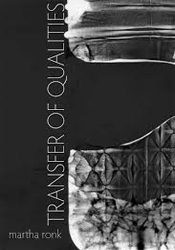
“The past is hidden somewhere outside the realm, beyond the reach of intellect, in some material object…which we do not suspect,” relates Proust in In Search of Lost Time, and “as for that object, it depends on chance whether we come upon it or not before we ourselves must die.” In her ninth collection, Transfer of Qualities, Martha Ronk places before us a series of such freighted objects—objective correlatives, dialectical images, call them what you will. These are objects—material or written—which collapse time, reshaping the perspectives of their owners. It may seem strange to the contemporary reader that such an occupation still bears our attention, especially when objects in our grasp tend to epitomize disposability (how quickly the iPhones replace themselves!), but Ronk’s work clarifies just how rare and crystallizing these moments of recognition tend to be.
In Transfer of Qualities, Ronk’s project is one more of synthesis than innovation. She acknowledges debts to Eliot, Pound, Moore and James rather directly, and the concluding bibliography runs to a page and a half. She is a poet who has come to terms with the crushing weight of preceding scholarship. Rather than take issue with her forebears, she determines to live in the world, experience both the profound and chimerical powers of things. If she sets the goal of navigating a series of tested beliefs, she does so with the condition of preserving and developing her own voice, her own rigorously informed selfhood. The second stanza of an early poem, “A Glass Bowl,” illustrates the difficulty:
Someone has come in the room and moved the chartreuse glass bowl so chartreuse as to seem a gigantic smudge, and suddenly the room begins to swim. The bowl floats in a wobbly arc into the foreground, the rest of the room dims and you feel suddenly and uneasily intimate with the glassy and sickly surface, glazed over by displacement.
Note, here, how the manner in which the object orders experience—even the material facts of the object itself—clearly invokes the important predecessor of Stevens’s “Anecdote of the Jar”:
I placed a jar in Tennessee,
And round it was, upon a hill.
It made the slovenly wilderness
Surround that hill.
The wilderness rose up to it,
And sprawled around, no longer wild.
The jar was round upon the ground
And tall and of a port in air.
It took dominion everywhere. […]
Stevens’s jar tames wilderness by altering its context; so too does Ronk’s glass bowl, which even at apparent rest mimics the blur of the moving earth. Furthermore, Ronk’s narrative perspective admits that it is made “uneasy” and (by transference) “sick.” If Stevens holds himself apart from the powers of the object in order to dispassionately describe it, Ronk surrenders to it, and what we have is a survivor’s narrative.
The first quarter of Transfer of Qualities is devoted to these discrete engagements with objects and their attendant philosophies (an approach to which Ronk returns in the brief and stirring “Portraits” section). They are an effective draw, beginning as they do in second person with an intimacy of address that points to the specific rather than the general ‘you.’ “The Folded Muslin” is a stirring investigation into the nature of belief, as the fabric appears to begin everywhere just where the self ends. The beholder is “[u]nable to keep [the muslin] an object ‘out there’”; ultimately, the material “undoes even the little one knows of science and leaves one utterly enclosed and mute,” in the confounding fashion of a belief one is powerless to rationalize or translate. Eventually, the narrator assumes first person, and the collection more-or-less permanently assumes the relation of inquiry addressing itself.
The poems of the middle of Transfer of Qualities often incorporate post-graphs, and while the additional voices—Donne, Blanchot, Heidegger—are instructive, the effect is summative, a closing off antithetical to poetry’s intimation of possibilities. It is important to note that all save one of the poems in Transfer of Qualities are prose poems. This works in Ronk’s favor when the poems function themselves as artifacts, figurative containers of the discrete objects that are their concern. However, in the middle section, where philosophical discourse is addressed head-on, the writing reads like conventional prose, and the sections feel nearly indistinguishable from paragraphs (a representative example from “Photograms”: “Ruins show us a world in which beauty or sublimity is sealed off: it is a melancholy world in which no recollection is possible; eternity appears, not as such, but diffracted through the most perishable.”). The didactic nature of this section betrays a rather nervous concern for the possibility that it might be misunderstood, an impulse of which poetry—even prose poetry—is blissfully unaware.
But Martha Ronk is an exceptionally gifted practitioner of the prose poem, so what is going on, here? In short, she is aiming for a hybrid form of inquiry, one that disguises its transitions. The hybrid form is a viable genre for poets, and it has been deployed successfully by, for instance, Anne Carson in Decreation, Cole Swenson in The Glass Age, Massie Nelson in Bluets and Camille Dungy in Suck on the Marrow. These are collections that allow the economy of poetry to govern both the recognizably poetic sections and the sections whose modus operandi are non-poetic (philosophical, historical or psychoanalytical). Unfortunately, the philosophical sections of Transfer of Qualities too often exceed poetry’s necessary and vitalizing economy, and the result are sections that do not quite satisfy either the reader of poetry or the enthusiast of philosophy. Still, the ambition of Ronk’s hybrid project is admirable, arising as it does from a need to articulate a genuine paradox (“what I’m after is without form,” from Transfer of Qualities’s only lineated poem, “Collecting Air”). The early section weighs the possibilities of objects, including “containment” of history, transference of emotion, etc., while the subsequent middle section suggests the many ways in which these relationships give rise to sometimes elegant but just as often maddening and contradictory reverie. The object exerts on the collector (and we are all collectors, to some extent) a power that is unhealthy. Materiality suggests that by externalizing our feelings and memories on important objects, we can “fix” ourselves in time and space…but, the middle section asks, does this really get us any closer to knowing ourselves? The conundrum is particularly insidious for the writer, a sort of collector par excellence, for whom semiotic dislocation mirrors the gulf between objects and their original, intended uses. If what the speaker is after is “without form,” this serves equally as an admission that objects do not suffice in anchoring the selfhood of the collector, with the further, harrowing implication for the writer that words may not be up to the task, either.
The short final two sections of Transfer of Qualities are entitled “People” and “Transferred Fictions.” Some of the narratives described therein are indeed captivating, but they are a departure from the ways of seeing and thinking cultivated in the previous forty-five pages, if only for the reason that people are exempt from the sort of familiarity of the object, upon which history and emotion are so easily projected. “Audubon” is one of the exceptions: it relates that in doing his work, Audubon “resort[ed] to killing the bird [a bald eagle] in order to be able finally to paint the picture.” In aspiring to the most lifelike depiction, Audubon turns a subject into an object through the act of killing. A later poem, “Where One Lives and Doesn’t,” epitomizes the contested nature of the stories we attach to objects. But by this far in Transfer of Qualities, we already know not to trust the apparent stability of the material world. We can collect, rearrange and divest all we want, but we will never fully possess.





